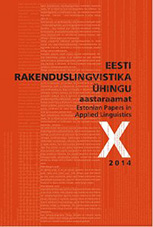Palved eesti, soome ja vene keeles: grammatika pragmaatika teenistuses
REQUESTS IN ESTONIAN, FINNISH AND RUSSIAN: GRAMMAR AND PRAGMATICS
Author(s): Renate Pajusalu Subject(s): Language and Literature Studies
Published by: Eesti Rakenduslingvistika Ühing (ERÜ)
Keywords: interrogative; address forms; conditional mood; negation; Estonian; Russian; Finnish
Summary/Abstract: The article discusses the formulation of requests in Estonian, Russian and Finnish. The data was collected by a discourse completion task: participants had to write what they would say or write in a given situation. 200 requests in each of the languages were collected. The article compares ten of the presented situations in three languages based on this data, bringing out the similarities and differences. The analysis focuses on grammatical categories that are pragmatically essential to the formulation of requests (sentence type, morphological form of the verb, presence of negation, address by singular or plural pronoun). The main unit of analysis is the head utterance (request proper) of the reply. However, in some categories the whole replies are considered. In the summary, generalizations are made about the more frequent grammatical devices used in the formulation of requests. All three languages typically used interrogative sentences to formulate requests. However, in Russian the number of imperative sentences was somewhat greater than in Estonian and Finnish. Another grammatical device common to all three languages was the conditional verb form. The conditional was most frequent in Finnish and least frequent in Russian. Negation was characteristic of requests only in Russian, where it occurred both with and without conditional forms. In Finnish there were no occurrences of negation, while in Estonian it was observed on rare occasions. Address by plural form was most frequent in Russian, less frequent in Estonian and least frequent in Finnish. Estonian is placed between Finnish and Russian in the frequency of all grammatical categories studied, which can probably be explained by the fact that Estonian is influenced by both Finnish and Russian.
Journal: Eesti Rakenduslingvistika Ühingu aastaraamat
- Issue Year: 2014
- Issue No: 10
- Page Range: 241-257
- Page Count: 17
- Language: Estonian

